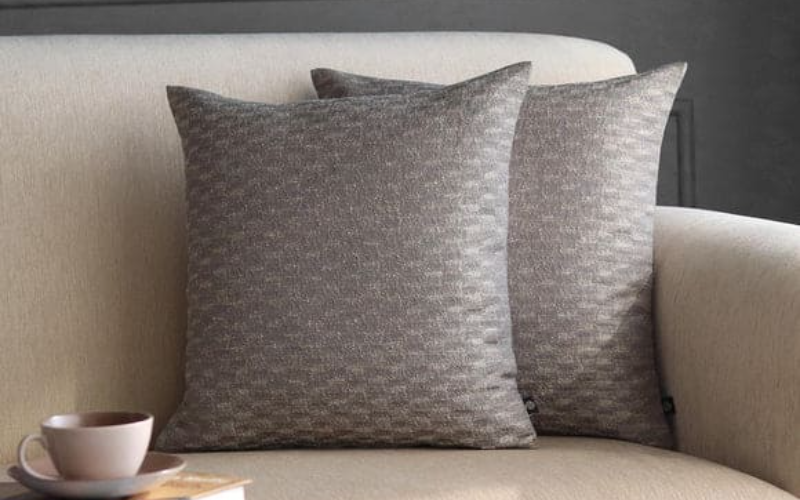Introduction
Think about it when was the last time you noticed how much of a difference a small detail made in your living room? Sometimes it’s the way sunlight falls on a corner, sometimes it’s the vase of flowers on the centre table. And very often, it’s thecushion covers.
They don’t just protect cushions. They set moods, bring warmth, and make spaces feel lived in. In 2025, cushion covers in India are playing a bigger role than ever blending tradition with innovation, luxury with sustainability. This blog takes you through market insights, design directions, and styling ideas to help you reimagine your home with GM Fabrics’ signature touch.
The Role of Cushion Covers in Indian Homes
For many of us, cushion covers hold memories Diwali evenings on the sofa, family chats after dinner, or lazy Sunday afternoons. They’re small, but they tie the room together.
In compact flats, simple beige or white cushion covers add airiness. In larger homes, layering bold patterns with textured fabrics creates richness. And in hotels or resorts, they are finishing touches that define a guest’s first impression of comfort. GM Fabrics has long understood this balance between practicality and artistry, designing covers that make everyday living feel refined.
India’s Cushion Covers Market in 2025
The cushion and pillow segment in India is no small player. It was pegged at ₹782.5 crore in 2024 and is set to touch ₹1,351 crore by 2033, growing at 5.8% CAGR. The push comes from a rising middle class, e-commerce convenience, and hospitality’s appetite for fine décor.
What’s trending in searches this year? Terms like “white sofa cushion cover” and “beige cushion covers” are showing up repeatedly—pointing to a love for subtle, minimal aesthetics. On the flip side, boutique hotels and high-end homes are choosing richer textures and artisan finishes. It’s a tale of two markets, both thriving.
Top Cushion Cover Trends in India (2025)
1. Sustainable and Eco-Friendly Choices
Sustainability isn’t a buzzword anymore—it’s a way of life. Cushion covers made from organic cotton, bamboo, linen, and even recycled polyester are in demand. They’re breathable, durable, and kind to the skin. Kilim-style cushion covers, handwoven by artisans, are gaining particular favour among eco-conscious buyers. Interestingly, nearly 70% of Indians say they’re willing to pay more for sustainable décor.
2. Luxe Textures & Fabrics That Speak Luxury
Velvet, bouclé, sherpa, and microsuede are the fabrics to watch. Jewel tones like emerald, cobalt, and mustard dominate, making spaces feel plush. And the details—mirror embroidery, tufting, tassels—turn even a plain cushion cover into a luxury accent.
3. Colours and Patterns with Personality
This year is all about balance. Earthy neutrals like sage and terracotta calm the eye, while bold jewel tones like sapphire or emerald add drama. Indian motifs—from Madhubani to block prints—are being digitally reinterpreted for durability and vibrancy. Young buyers, meanwhile, are gravitating towards abstract watercolours and geometric designs.
4. Personalisation and Custom Work
Cushion covers are becoming deeply personal. From monogrammed initials to custom embroidery, people are choosing covers that reflect identity. For hotels, custom branding has turned cushion covers into subtle but powerful branding tools.
Cushion Covers in Real-World Spaces
- Urban Homes: Small apartments favour neutrals and easy-to-clean fabrics. Yet, layering works wonders—think oversized velvet squares paired with smaller block-printed lumbars.
- Hospitality & Luxury Living: For hotels, cushion covers aren’t just décor—they’re a mark of luxury. Antimicrobial finishes, embroidery, and branded textures elevate rooms instantly.
- Artisan & Sustainable Choices: Millennials and Gen Z are gravitating toward handwoven cushion covers. They’re stylish, yes, but they also carry a sense of responsibility and cultural pride.
- E-Commerce & Global Exports: Online, microsuede and solid-colour cushion covers top sales. Globally, Indian cushion covers continue to travel far—nearly 3,000 shipments last year alone, with the US and Japan leading the list.
What Buyers Want in 2025
Today’s buyers are clear about what they want from their cushion covers:
- Eco-consciousness: They want products made responsibly, with natural or recycled fabrics.
- Comfort: The tactile feel matters. Soft, plush, and cozy covers win hearts.
- Flexibility: Mix-and-match options let people update styles without overhauling entire rooms.
Styling Cushion Covers: Expert Tips
- Layer Textures and Sizes: Combine velvet with cotton, or bouclé with embroidery, to create depth. Try oversized floor cushions with slimmer lumbar covers for a designer look.
- Play with Colour Stories: Start with earthy neutrals, then add a strong accent—say mustard or jade green. Keep one piece as a statement motif, like a Madhubani print, against solids.
- Switch with the Seasons: Summer calls for light cottons in pastels, while winter feels right with velvet or sherpa cushion covers. Small swaps keep interiors fresh.
- Choose Sustainable Options: Handwoven, organic, or upcycled cushion covers don’t just look good—they tell a story and support artisans.
Conclusion
The world of cushion covers in India is evolving quickly. What was once purely functional has now become a canvas for style, comfort, and personal storytelling. In 2025, trends are leaning towards sustainable materials, lush textures, versatile colour palettes, and personalised touches.
For GM Fabrics, cushion covers aren’t just accessories—they’re part of a lifestyle. They carry memories, create moods, and elevate spaces with elegance. Explore more atGM Fabrics and discover designs that turn everyday living into something extraordinary.












